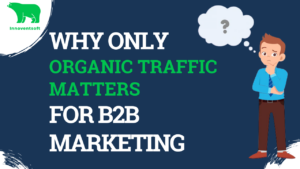In the B2B space, blog content marketing is not only a powerful tool to increase brand awareness, but it generates quality leads. That’s why 90% of B2B marketers use blogs (short articles/posts less than 3,000 words) as their primary content asset.
To keep your blog running like a well-oiled machine, you need to have a content calendar. A content calendar is nothing but a list of content that you’ll be publishing for a specific period.
But how do you come up with quality content topics for your calendar?
The answer to that question lies in adopting a customer-centric approach to your content marketing strategy. And that’s why these four steps form the core of creating a blog content calendar:
Step #1: Know your customer type
The very first question product or content marketers should ask before creating a content calendar is about their ideal customer profile: Who are my customers or target personas and what do they care about?
In the B2B scenario, a purchase happens with a lot of reasoning since different stakeholders, who could influence the decision, are involved. So, there are different customer types and respective target personas, and it’s crucial to reach all of them to make an effective content calendar.
Generally, B2B customers or stakeholders can be classified into three categories:
- Buyers
- Influencers
- Users

Now, let’s look into these three groups. (To cite examples, let’s assume that your company sells a software product for developers)
1. Buyer
A buyer is a person who has the final say in the purchasing process and ultimately makes the purchase. Since they have access to the money needed for the purchase, they analyze how the product positively affects the organization. It can be an increase in revenue or reduced costs. They also evaluate if there are any risks associated, such as security vulnerabilities or non-compliance, which can be a headache for their brand later on.
Example: CIO, VP of Engineering who holds the budget.
2. Influencer
An influencer is someone who has high technical skills and influences the buyer. They usually have years of experience in the domain. Typically, they test the product, analyze the feasibility and technical aspects, and recommend the product to buyers. And they deeply care about the implementation and impact of the product on their users and workflow.
Example: Director of Engineering, Senior Managers
3. User
It is someone who actually uses the product and is most impacted by the purchase. They mainly care about the use cases of your product and how it will improve their efficiency. They may ask these questions about the product: Is the product better than what I already have? Is it easy to learn and adopt? Does it make my job easier?
Example: Software Engineer, Application Specialist
(As a side note, there can be more than these three groups influencing purchases, or maybe an influencer will be the buyer. It all depends on the size of the organization, but these three groups cover most of the customer base in a B2B scenario.)
The three groups will have different goals to achieve using your product. For example, while a user will be concerned about making their existing process easier, the buyer will be more interested in increasing the ROI of using the software.
As a content marketer, your job is to create content for all of them, based on their goals, needs, and aspirations.
But, will that be enough to come up with a content calendar?
No, because your potential customers will be at different stages of the sales cycle depending on their level of knowledge regarding the problem at hand and the solution (your product).
This brings us to the second step of creating a blog content calendar.
Step #2: Understand the requirement in customer lifecycle stages
A customer lifecycle journey represents the sequence of stages through which someone, who doesn’t know about your product, goes through until they decide to buy from you. We can use the classic AIDA model to track the movement of prospects into customers. Content marketers have to understand the content requirement of various target personas in each stage of the customer lifecycle journey.
The AIDA model
The famous AIDA model is useful to describe the customer lifecycle journey using 4 important stages: Awareness, Interest, Desire, and Action (AIDA). There are many variations of the elementary model available such as DAGMAR, AISDALSLove, etc. But we will use AIDA for the sake of simplicity.

1. Awareness
This is the very first stage in the model where a prospect comes to know about your product for the first time. For example, let’s assume that you’re a B2B SaaS provider. The prospect in the awareness stage will be someone who just came to know about your product while looking to solve a problem.
2. Interest
In this stage, the problem-aware prospects are genuinely interested in your product and want to learn more. This makes a prospect engage more with your content, and they may fill out some forms on your website or download a lead magnet. Eventually, your prospects become leads and enter your sales funnel.
3. Desire
By learning more about your product and its capability to solve their problem, the leads’ interest gives way to a desire to purchase your product. They realize they need your SaaS solution, after comparing different products with the same offering as yours.
4. Action
In this final stage in the AIDA model, a lead takes an action to become a customer. That is, out of a desire to purchase your product, the leads take specific actions like requesting a demo and eventually completing the purchase.
Step #3: Create a content map and use keywords for SEO
Once you have developed the understanding of your target personas and identify their requirement of content at various stages of AIDA, you can plot a content map (we will see an example later). Note, the content map is a living document which will get modified based on organizational priorities. Sometimes a new product launch would add a few more line items in the content map.
Research on top 10-15 keywords that your organization wants to target based on SEO goals. If you have a digital marketer who can help you provide the keyword analysis, then great, else you can focus and discuss with other marketing stakeholders to develop the keyword research.
In this step all we need to do is marry the content map with the keywords. You can choose certain content topics and target specific keywords. A careful consideration one has to make is not get carried away with a laser-sharp focus on keyword ranking and add content which might be good for SEO but may be worthless for customer conversions.
Step #4: Take sales and marketing feedback & finalize the content calendar
After a content map is prepared you can prioritize content to generate based on the input from sales and other leaders in the organization. The prioritization may depend on various parameters such as marketing campaigns, sales discovery calls, prospect nurturing, etc. Thus discuss with senior leaders from sales and marketing, take their feedback to align your content generation based on the market demand and finalize the content calendar.
Your content calendar will be a living document with the content map along with the prioritized list of content for a time period.
Putting the pieces together with an example
Once you identify your customer types and their lifecycle journey, creating a content calendar is like joining the pieces of a puzzle. Use a simple spreadsheet or any other software of your choice. All you have to do is arrange the customer types in a column and the stages of their lifecycle journey in a row, and follow the 4-steps as discussed above.

Let’s look at it using an example. We shall create a content map based on the below product information in hand.
- Name of the product name: XYZ
- Market: Automatic SEO analysis
- Target audience: CMO, Digital marketers, performance marketers
-
Customer types:
- Buyer – CMO
- Influencer – Digital Head
- User – Digital Marketer
- Keywords: SEO, online marketing, website content optimization
Please refer below highlighting the sample of (non-exhaustive) content map for the product XYZ
Awareness |
Interest |
Desire |
Action |
|
Buyer |
New trends in online marketing and SEO |
Business benefits of SEO analysis |
Top tools for SEO analysis |
XYZ’s ROI in SEO analysis |
Influencer |
How to achieve website content optimization using XYZ |
Feature and benefits of XYZ |
XYZ vs ABC |
XYZ integrations for faster adoption of SEO analysis |
User |
Know how to save time on optimization using SEO tools |
How to perform SEO, How to perform content optimization |
Get started with XYZ SEO tool in 2 steps |
Free trial for XYZ SEO tools. |
Figure A: highlights the content map targeting various personas at different stages of customer lifecycle journey
Rinse and repeat
So put up a content calendar and start generating content that matters. But if you want your content calendar to be effective don’t forget to measure it. There is no better way to understand what works with your audience than actually measuring your content performance.
You can use a content marketing tool to understand the impact of the content on your website, lead generation and revenue. With constant reference to the KPIs, you can optimize your content calendar by adding new content and prioritizing the content cadence to maximize the impact.
Monitoring your content performance and paying attention to the engagement will help you get new insights into areas you didn’t think of at first. Based on the data (what works and what doesn’t), change your content calendar and ensure that they align with your organizational sales and revenue goals.





